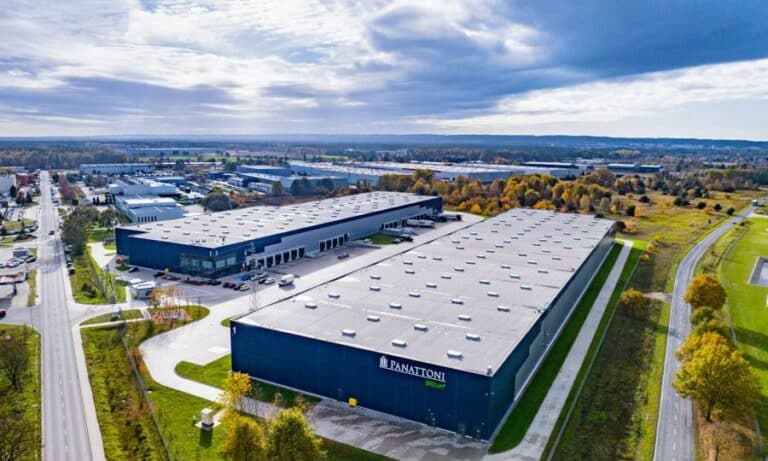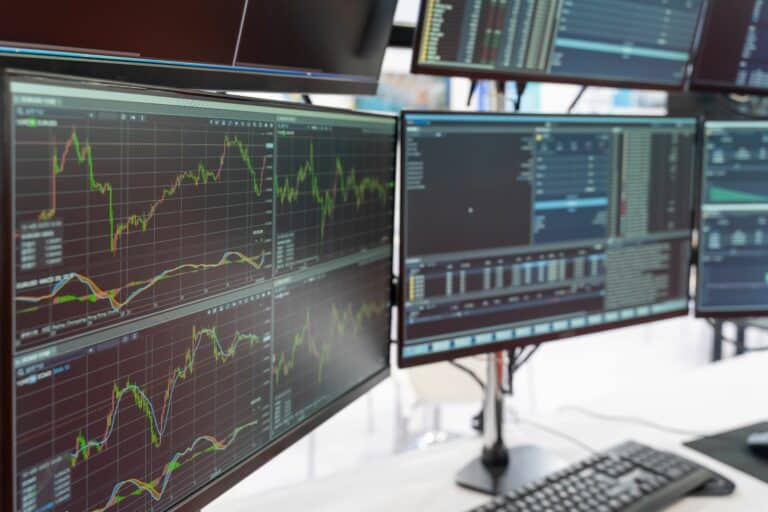E-commerce, ESG and automation
Agnieszka Bulus-Trando talks to Damian Kołata, Partner, Head of Industrial & Logistics Agency Poland, Head of E-Commerce CEE, Cushman & Wakefield
Let’s start with logistics, which is currently very dynamic and changing under the influence of online sales. How does e-commerce affect logistics and warehouses?
The growing role of our country as a European logistics hub, as well as the further development of e- commerce, as well as turbulence in global supply chains mean that warehouse space enjoys and will continue to enjoy great interest. The most optimistic data show that in the US in the first three months of the pandemic, the e-commerce logistics market made a leap that could be achieved in 10 years of standard development. The warehouse is no longer a place where old men move around on forklifts, moving pallets from the frame to the pallet rack. A modern warehouse, primarily to support the electronic sales channel, is a place of many and varied processes, the existence of which is necessary to achieve and maintain a decent market position, on the one hand, and on the other hand, the implementation of which requires several times larger warehouse space. Experts say that modern omni-channel processes require threefold more warehouse space than standard pallet manipulations. We must be aware that the warehouse space is a picking place in the fragmentation of one item, and not as it used to be, just one pallet or at most a cardboard box. In addition, returns management and other value-added services have specific requirements that developers meet, and we advise on this in advance. The warehouse becomes a place of innovative processes, the coexistence of manual work and automation, as well as a comfortable social space where employees prepare for work, rest, eat a meal in a neat canteen, or wait for a transfer home, which is often covered by the employer. The new reality makes us look at the warehouse differently than before. This is what we do, and external conditions motivate us even more, bringing new challenges.
Staying with e-commerce. According to your report, parcel lockers drive this market. What is behind the growing popularity of parcel machines among Poles?
Delivery of a parcel to a parcel machine is the most frequently chosen form of delivery in Poland. The domestic market is an absolute exception in this field in Europe. According to the report “E-Commerce in Poland 2021,” prepared by Gemius, as many as 77% of online buyers use this form of delivery, which means an increase compared to the corresponding survey from 2020 by as much as 16%. In second place (50%) was courier delivery directly to home or work. As many as 81% of Poles who buy online, the form of delivery to a parcel machine is an element that motivates them to place an order. For obvious reasons, we don’t always have time to wait for the courier at home. In the workplace, the possibility of collecting a package is also not a matter of course. Telephone contact with the courier in order to arrange a re-delivery is also often difficult. Certainly, not only for me, the adventure with courier delivery often ended with a visit to the far suburbs of the city in order to pick up a package from the courier’s warehouse. For this reason, parcel machines have become the number 1 collection point in Poland. It cannot be denied that the increasing popularity of parcel machines on our market is associated with ecology and care for the environment. According to the information provided by the largest operator of such devices in Poland, InPost, as many as 37% of respondents reach Parcel Lockers on foot. In addition, 61% of people using InPost services admit that they use Paczkomaty only when dealing with other matters. Moreover, 93% of respondents do not make a long way or drive a maximum of 5 km to reach the pickup point. Research carried out by scientists from the AGH University of Science and Technology in Krakow has shown that by delivering many parcels to one place, carbon dioxide is reduced by up to 95% and annual fuel consumption by over 20 million liters. A special calculator developed by InPost indicates that if traditional home deliveries were replaced with delivery to a parcel locker, CO2 emissions could be reduced by up to 75%. The Polish parcel apparatus market is the largest in Europe. There are almost 20,000 points in our country. Undoubtedly, the biggest player is InPost, whose network already has 16,000 parcel machines. Many parcel machines are also located in smaller towns, which makes the company’s offer available to many consumers.
The growing importance of e–commerce is one of the key trends in the warehouse and logistics industry. Automation is the second. However, as with everything, you also have to be somewhat wary here, because an automatic solution will not always turn out to be the best. So what solutions would you now indicate as the best, and which would you still consider?
When discussing the automation of logistics processes, we should be aware that it is an indispensable element of today’s logistics. Logistics which cannot be a cost center for companies and should not be seen as a place where the profit and loss account can be easily optimized in case of problems, but logistics as a place where a competitive advantage is achieved. Regardless of how clichéd this slogan is and how easy it is to fit it into many activities within the organization, logistics has certainly become a field that has proved, like no other in recent times, that its earlier depreciation can be disastrous. A forklift, pallet, high storage rack, and even a warehouse management computer system is not enough to provide modern logistics services. Of course, we don’t have to move to modern and fully automated centers straight from movies showing the outsides of Chinese internet giants. We should also remember that the implementation of automation will not be a magic wand that will quickly solve all sorts of ills. Also, not always will only automatic solutions be the best. However, it is worth bearing in mind that by fighting for better and better efficiency, eliminating bottlenecks in the sequence of processes, wanting to maintain greater precision and taking into account problems with access to human resources and increasing labor costs, automation will be an increasingly common solution. If we add to this the saving of space (for example, the AutoS-tore system allows you to quadruple storage space without having to move to a new building, and at the same time improve the throughput of order fulfilment up to tenfold without hiring additional staff) and low energy consumption (completing robots do not use more energy than a domestic vacuum cleaner), as well as the invaluable help of automatic solutions in the case of occupational health and safety and the handling of hazardous materials, it seems that soon every warehouse will be equipped with at least partially automated processes. It is worth remembering that a warehouse worker spends up to 50% of his or her working time moving from one location to another, and the costs of picking constitute up to 50% of all warehouse costs. So each optimization in this area will be a significant saving.
Other trends that I would like to talk about are e-grocery, q-commerce, dark stores and dark warehouses. Please tell me about these trends and what is their development in the West and in Poland?
Another noticeable trend that connects last and this year is the boom in e-grocery and quick grocery shopping, which we became interested in in 2020, starting with the outbreak of the pandemic. Back then, the name q-commerce was an unclear cipher, now quick commerce is an increasingly frequent element of e-commerce, which consists of fast, even 10-15-minute – delivery of groceries ordered online, to the door of our apartment. Certainly, you have the opportunity to notice many times in the streets characteristically dressed cyclists and motorcyclists who carry their shopping in square bags. Readers who are passionate about logistics will probably ask where these purchases come from. While in the initial phase they were simply made in stores, recently, in the largest Polish cities, they are being created like mushrooms after rain. Dark stores can be of various sizes – local stationary stores, but also large fulfilment warehouses with an area of several dozen thousand sq. m. (especially in the US, where dark stores are created in the place of liquidated shopping malls, as described above, and are called ‘dark warehouses’).
They are usually located in cities or right next to communication routes. In Poland, the concept of smaller dark stores is currently developing, which often take up places in commercial premises of housing associations and do not exceed 200-250 sq. m., with about 1,500 SKUs in their offer. Companies such as Lisek and Jokr have already launched over a dozen such surfaces that resemble a grocery store from the outside (see the photo below) and from which they fulfill orders within a radius of about 2 km from a given location. Bolt, Glovo, Wolt, Gorillas and such big names as Żabka and Biedronka (in cooperation with Glovo, as BIEK, i.e. Biedronka Ekspress) are also preparing to open similar concepts in the near future. Importantly, q-commerce is also becoming more and more popular not only among customers, but also investors and venture capital funds. This year alone, these funds invested more than $1.5 billion in express grocery companies, while over the previous year it was almost three times lower ($687 million). Soon dark stores will appear not only in the supply of groceries, but also clothing. In addition, together with a warehouse in shopping centers and the FFS (fulfilment from store) system, they will create a new last mile supply network, which is much more efficient and effective. It is worth considering that, according to many industry experts, last mile costs range from 40% to even 55% of the total cost of supply chains. Hence, there are so many initiatives to optimize logistics and expenses for it in the field of city and last mile logistics, and to reorganize deliveries.
Let’s talk about specific figures. How did the previous year close in terms of supply and demand, transactions and warehouse lease?
Last year was an absolutely record-breaking year in terms of delivered space and its resources already amount to 24 million sq.m. It is also worth mentioning that as much as 7.5 million sq.m. were leased during the whole of last year, which is over 50% better than in the same period of the previous year. In addition, 4.5 million sq. m. are still under construction, almost 130% more than in the same period of last year. All these record levels have not contributed to an increase in the vacancy rate. On the contrary – their level is the lowest in history and amounts to only 3.8%, which is 3 percentage points less than a year ago.
When talking about trends, we cannot forget about ESG, and in particular, care for the environment. In the past, people talked about photovoltaics in this respect. Now there are many more of these solutions. Please tell me what ecological solutions are used in warehouses and what are the benefits for the environment and savings for companies?
Last year, we noticed a real and ever-increasing emphasis on sustainable solutions. The European Commission climate target is to reduce emissions by at least 55% by 2030. In the decades to come, greenhouse gas emissions are expected to decline gradually so that the EU can become climate neutral by 2050. It is important that ecology means huge savings. According to the calculations of various developers operating on the Polish market, with the use of photovoltaic panels, increased wall and roof insulation, LED lighting and an energy management system, energy consumption in the building drops by up to 50%. LED lighting consumes 90% less energy than a standard bulb. In turn, the intelligent lighting control system DALI (Digital Addressable Lightning Interface) adjusts the light intensity to changing environmental conditions. It uses motion sensors and activity diagrams, ensuring optimal working conditions and effective energy management. Electric car chargers, planting of vegetation, flower meadows or green roofs, in turn, allow for the reduction of carbon dioxide emissions by about 381 tons per year for a medium-sized warehouse. From the tenants’ point of view, it is also important that green solutions affect the well-being of their employees. The greenery around the building, relaxation zones, street furniture and bicycle infrastructure increase the efficiency of people satisfied with their workplace.
The last question is about the future of the industry. Do you see here rather a development towards last mile warehouses or rather large cross-border hubs focused mainly on export and import abroad?
E-Commerce and the pandemic have changed the supply chain tremendously. Many new types of warehouses have been created, both the last mile hubs mentioned by you, or areas targeted at cross-border e-commerce, but also sorting plants, return centers or locations that support only re-commerce. The narrow structure of the traditional supply chain with only a central warehouse and possibly a few regional warehouses is a thing of the past. Nowadays, logistics chains have to cross at
every order, pick-up, delivery and return point, which significantly extends the types of warehouses and their locations. So I am convinced that the coming months will bring the development of not only large hubs, but also smaller locations related to the CEP industry and the widely understood omni-channel phenomenon.







